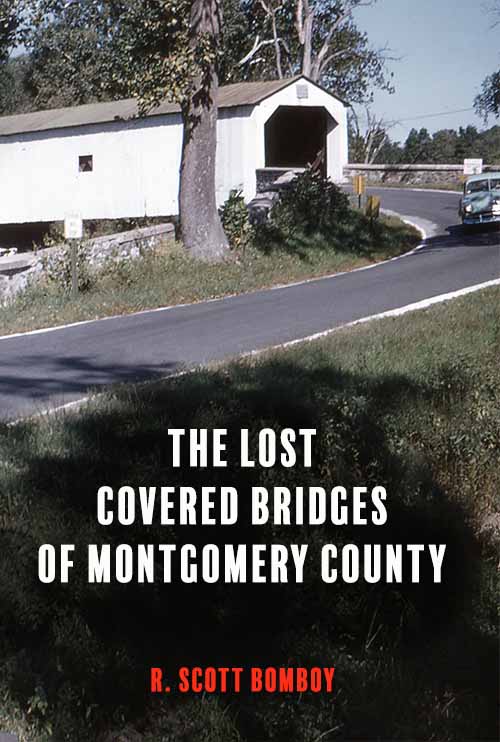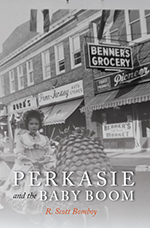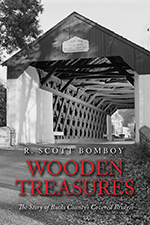For the past year, I have been researching the 51 covered bridges that once existed in Bucks County, and one question I’ve been asked is how do we really know that Perkasie’s bridge was built in 1832?

After digging up some old records, it turns out
Bucks County commissioned the bridge and then paid for it between March 1832 and January 1833. But the 1832 bridge wasn’t the first attempt to put a bridge in the same location over the Pleasant Spring Creek. And the bridge wasn’t known as the South Perkasie bridge until 1899 at the earliest.
Today, the South Perkasie bridge is the oldest covered bridge in Bucks County and the third-oldest in Pennsylvania. It is also the third-oldest Town Lattice bridge in the United States.
The South Perkasie covered bridge’s early story starts sometime in the mid-1790s when a former wagon driver in the Revolutionary War, Benjamin Rosenberger, bought property in Rockhill Township and acquired water rights from his neighbors to start a grist mill. Research commissioned by Ralph Beaver Strassburger, a descendant of another owner of the same mill, put that date in late 1795. The Rev. John Andrew Strassburger, Ralph’s great-grandfather, bought the mill and its surrounding property in 1825.
Rosenberger had tried to have a bridge built near the mill in 1821. Back then, landowners had to petition the Bucks County Court of Quarter Sessions to convene a grand jury to send inspectors to look at a prospective bridge location. If the inspectors, grand jury, and the court agreed, the county would pay for a bridge. If not, people had the ford the creek on their own.
On March 1, 1821, the court sent five men to inspect the location near the mill. On May 31, 1821, the inspectors said a bridge was needed there, but the grand jury denied the petition.

A decade later, not only was the mill’s new owner, the Rev. Strassburger, a pastor at four local churches, but he was also considerably wealthy through inheritance. In February 1831, the county dispatched another inspection team to the Pleasant Spring near Strassburger’s Mill and the inspectors ruled again in favor of a bridge. This time, the grand jury agreed with the inspectors, but the court refused to act on the petition in April 1831. But on February 18, 1832, the court approved construction of a new bridge.
The Doylestown Intelligencer published the county’s 1832 budget in February 1833 and confirmed the Pleasant Spring Bridge was completed at a cost of $1,329.41. Financial records show two covered bridges, Pleasant Spring and Wolf (later known as the Chain Bridge), were built in 1832. The only easily identifiable covered bridge built by the county before then was the Newportville Bridge in 1824 (which was later lost in an 1865 flood).
But why did the county agree to build a bridge in Rockhill Township a decade after it refused a request from the Rosenbergers? In the research commissioned by Ralph Strassburger, it is clear the Rev. Strassberger had invested in his mill, had other considerable landholdings (including a second mill), and he was widely respected. Strassburger’s Mill produced flour and feed, and the bridge sat at the intersection of roads that connected several villages.
Also, new lattice-design covered bridge technology introduced by New England architect Ithiel Town made bridge building more affordable compared with stone-arch bridges. The Newportville bridge probably used the more-expensive Burr Arch design and it cost nearly $6,000 when its covering was added in 1824. The Wolf Bridge in Wrightstown replaced a chain-style bridge and cost about $1,000 more than the Pleasant Spring covered bridge, but it was twice as long. In 1832, Bucks County’s total revenue from taxpayers was about $30,000 and bridge costs represented about 25 percent of the county’s budget. Covered bridges saved the county a lot of money in locations that had required stone arch bridges, or at spots where arch bridges weren’t practical.
After the Pleasant Spring Bridge was completed in 1832, Strassburger’s Mill facilitated the formation of a village called Bridgetown near the covered bridge and the mill. In the 1850 census, the Rev. Strassburger was the second-wealthiest landowner in Rockhill Township. After Strassburger’s death in 1860, Abram A. Hendricks eventually acquired the mill, which was subsequently owned by James Savage and then the Benfield family. The mill’s success was tied to the covered bridge, as was the Savacool Mill in Bridgetown, which was built in 1866. A third mill, Groff’s Mill, also benefited from the covered bridge.

In the county budget records, the first use of the words “South Perkasie Bridge” occurred in 1900. The term “South Perkasie” starting appearing newspaper in 1899, after the village of Benjamin (formerly Bridgetown) joined Perkasie Borough.
As to who built the bridge initially, that remains an open question. It is true the first three covered bridge builders in America, Timothy Palmer, Theodore Burr, and Lewis Wernag, got their starts as millwrights. And in today’s dollars the cost to build the Pleasant Spring Creek bridge was about $38,000.







One Comment
Very interesting article. Thanks for sharing it with us.